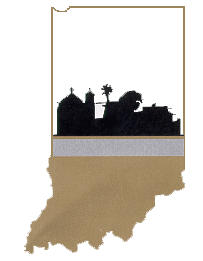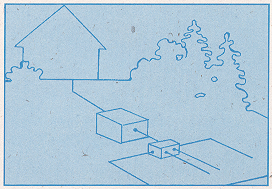
Indiana Farmstead Assessment for Drinking Water Protection
Household Wastewater Treatment

 |
Indiana Farmstead Assessment for Drinking Water ProtectionHousehold Wastewater Treatment |
 |
Introduction Septic tank/soil absorption system Quantity of wastewater Consider the following ways to minimizewater use Quality of wastewater
Consider the following ways to improve wastewater quality Collection of wastewater Preteatment System Disposal of wastewater and pumpage
Assistance with failing systems or new designs Authors Sources
A properly installed and maintained system for treating and disposing ofhousehold wastewater will minimize the impact of that system on groundwater and surface water. State and local codes specify how wastewater systems mustbe designed, installed and maintained. The Indiana State Boar d of Health, Rule 410 IAC 6-8.1, regulates private sewage systems.
At a minimum, follow the codes; but also consider whether the minimumrequirement is sufficient for your site.
The most common form of onsite wastewater treatment is a septic tank/soil absorption system. In this system, wastewater flows from the household sewer into an underground septic tank.

Reducing the volume of wastewater entering the treatment systems is important because less flow means better treatment, longer systemlife and less chance of overflow.
The quantity of water used depends uponthe number of people using the dwelling, how water is used and maintenance of the watersupply system. Average water use in rural households is 40 to 50 gallons per person per day. With lowuse fixtures and individual awareness and concern, a reduction to less than 25 gallons perperson per day is possible.
Reducing the volume of water entering thesystem will improve the treatment by increasing the time the waste spends in the system, thusproviding more time for settling, separation and more soil contact.
Eliminate nonfunctional uses, such asflushing toilets to dispose of tissues or other wastes that should be handled as solid waste. Turn off water between uses. Fix plumbing fixture leaks and eliminate sources of clear waterand infiltration into the system. (For example, divert roof drains away from the soil absorptionfield.)
Modern efficient plumbing fixtures canreduce home water use by 30 to 70 percent, see Table 1. Consider which actions use the most water. Toilet flushing usually ranks highest. Low-flow models could decrease water use by more than half. In the United States, 35 to 40 percent ofthe population has plumbing codes that require 1.5 gallon-or-less toilets on all new construction.
------------------------------------------------------------------------------- Table 1. Water Use by Conventional Fixtures and Water-Saving Fixtures and Devices ------------------------------------------------------------------------------- Conventional Gallons Water-saving Gallons fixture used fixture/device used ------------------------------------------------------------------------------- Toilet 4-6/flush Air-assisted toilet 0.5/flush Showerhead 4-6/min. Low-flow shower head 2/min. Faucets: Bathroom 4-6/min. Faucet-flow and Kitchen control aerators: Bathroom .5/min. Kitchen 1.5/min. Top-loading Front-loading clothes washer 40-55/load clothes washer 22-33/load ------------------------------------------------------------------------------- Installation of all these water-saving devices could reduce water use by 35 percent. Source: Penn State Cooperative Extension Circular 302.
Bathing and clothes washing are next inorder of water use. For bathing, consider such reduction options as installing low-flow (0.5- 2.0gallon per minute) or controlled-flow shower heads, taking shorter showers, and taking"wet-down-soap-up-without-water-then-rinse" showers.
For clothes washing use a suds-saver andrun full loads. Front-loading washers use much less water--20 to 27 gallons per 10 to 20 poundload. When running small loads be sure to use the reduced water level setting.
In hard water areas, the water softener maybe a significant user of water. Proper adjustment and timing of the softener's regeneration mechanisms can reduce excessive water use.
Keep in mind that your awareness of your family's water use and how each of you can reduce it is as important as the use of water conservation devices.
The quality of water refers to what is in thewater, not to the water itself. Even wastewater is more than "99.44 percent pure" water. Wastewater usually contains relatively small amounts of contaminants--but they make a big difference inthe usefulness of the water. Contaminants found in wastewater include:
Leaking pipes or infiltration of clear wateroverloads the system and dilutes the wastes. Don't allow water that doesn't need treatment(basement floor drain sumps, foundation drains, infiltration of rain water, roof drainage) to add to your waste volume. Divert clear water, which doesn't require treatment, away from house, welland wastewater treatment system.
Septic tanks retain most of the suspendedsolids (sludge and scum) from wastewater. In the tank, bacteria digest and compact the sludge. Thepartially treated water moves on to additional treatment and disposal in a soil absorption field.
Design and construction of septic tanksinfluence their water tightness and ef fectiveness of retaining sludge and scum. Multiple tanks orchambers in series can improve sludge and scum removal. Gas deflectors and filter screens orinclined-plate settling units help to minimize solids carryover. Tanks should be sized to accom-modate at least 24 hours of wastewater flow, while still allowing for sludge and scum retention. Pumping the tank before it is more than one-third filled, generally every three to fiveyears, improves function of the system. When the tank is pumped, you should also check the baffles and check for tank leaks.
Off-site disposal of wastewater, by connec-tion to a municipal sewage system, hauling to a municipal treatment facility or land spreading,can help protect the local farmstead water supply. Discharging treated wastes to surface water fromprivate systems is not permitted in Indiana. Improper waste management of the farm site canendanger the health of others in your community. Also, it may eventually contribute to poor waterquality at your well.
Application of wastewater to the soil surfaceprovides an opportunity to recycle nutrients and to further reduce the contaminant content ofwastewater in a safe manner. The application time should be chosen so that there will be littlerunoff, maximum use of nutrients by plants and additional reduction in microorganisms. Sitecharacteristics (soil, land use, depth to groundwater, weather, climate and hydrogeology)should be considered when selecting a site.
Subsurface treatment and disposal using soilabsorption (trenches, beds, mound, at-grade and gravelless) is the common practice for householdwastewater after pretreatment in a septic tank or aerobic system. There are, however, sites where soil absorption systems are not acceptable because of high or low soil permeability, depth tobedrock or the saturated zone, or other factors. Deep, well-drained, medium textured soils (suchas silt or silt loam) are most desirable soil absorption sites.
If wastewater is incorporated into surfacesoils the chances of runoff must be reduced. While wastewater applications are often controlled by the amount that will infiltrate, the rate of application should be estimated to match thenutrient uptake by vegetation harvested from the site, thus minimizing loss of nutrients to the groundwater.
Soils and separation from the water supply are important factors. Unsaturated soils allow movement of air, helping keep the waste water aerobic. A minimum of two feet of unsaturated permeable soil is recommended for removal ofbacteria. Finer-textured soils (clay loams and clays) have lower permeability and allow plantroots to take up wastewater and nutrients and allow sufficient die-off of microorganisms.Coarse, sandy soils may allow effluent to flow too quickly downward to groundwater and not provide adequate time for filtering of solids and pathogens from the liquid. Disposal sites that aremore distant and downslope from the well increase the isolation of your water supply fromthe contaminated wastewater.
Land application of wastewater and sludgemust only be done on sites permitted by the Indiana Department of Environmental Manage-ment (IDEM). An application is required and will be reviewed by IDEM. Approved sites for land application must meet requirements for soil, depth to groundwater or bedrock, slope, and distance from wells and residences.
If you suspect your household wastewatertreatment system is backing up or your distribution system is clogged, first contact your plumberor treatment system installer who may have suggestions for extending the life of your system.Your county sanitarian may also provide assistance and is the person to see for permits torepair or replace your wastewater treatment system.
A properly designed, constructed andmaintained septic system can effectively treat wastewater for many years. For more informa-tion on septic systems, contact your county extension educator or local health department.
Contacts and References Household wastewater treatment and local regulations Your county sanitary code administrator inthe county health department. State regulation of private sewage systems Indiana State Board of Health Engineering Section 1330 W. Michigan St. Indianapolis, IN 46206 317/383-6179 Requirements for land application Indiana Department of Environmental Management (IDEM) P.O. Box 6015 Indianapolis, IN 46206-6015 800/451-6027 Septic systems and land application technologies National Small Flows Clearinghouse West Virginia University P.O. Box 6064 Morgantown, WV 26506-6064 800/624-8301 Small Scale Waste Management Project University of Wisconsin-Madison 1450 Linden Drive Madison, WI 53706 608/262-0853 or -6968 What to read about ... Design, installation, use and maintenance of onsite sewage systems *ID-142 Operating and Maintaining the Home Septic System (1) *AY-9-33 Septic Systems Owner 's Guide (1) *MWPS-24 Onsite Domestic SewageDisposal Handbook (1) *Management of Decentralized, OnsiteSystems for Treatment of Domestic Wastes (CD ROM) (2) *Residential Water Conservation Techniques (CD ROM) (2) *RWASTE-IV, Residential wastewater treatment evaluation (PC software pro-gram) (2) Water-saving toilets and showerheads "How to save water," Consumer Reports, July 1990, pages 465-473
Sarah Brichford Cherri Jansen Joe Yahner Joe Eigle
1. Purdue University Cooperative Extension offices or Media Distribution Center 301 South 2nd Street Lafayette, IN 47901-1232 765/494-6794 or 1-888/EXT-INFO 4. Center for Technology Transfer and Pollution Prevention 1146 Agricultural and Biological Engineering Building West Lafayette, IN 47907-1146 765/494-1178
Click below for survey 6
Household Wastewater Treatment
| Reviewed 5/1/01 |
|
It is the policy of the Purdue University Cooperative Extension Service, David C. Petritz, Director, that all persons shall have equal opportunity and access to its programs and facilities without regard to race, color, sex, religion, national origin, marital status, parental status, sexual orientation, or disability. Purdue University is an Affirmative Action employer. This material may be available in alternative formats. 1-888-EXT-INFO. |